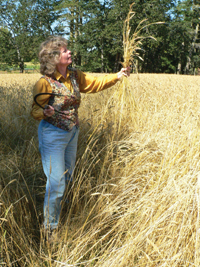
The Final Proof: April 2010
March 30, 2010
By Stephanie Ortenzi
Canada’s Sharon Rempel is using the power of stories to keep heritage wheats such as Red Fife alive and well for future generations
 |
| Sharon Rempel
|
Canada’s Sharon Rempel is using the power of stories to keep heritage wheats such as Red Fife alive and well for future generations.
Wheat originated in a fertile crescent of land we now call Iran and Iraq, as well as modern-day Ethiopia, has the world’s greatest diversity in wheat crops. But although there are hundreds of thousands of bread-wheat varieties in the world, in North America we use precious few, which is why Sharon Rempel’s work is so exciting.
Rempel is a Canadian agronomist and wheat activist. Her work is a reminder that there’s no need to lose something because “better” often means “more.” Casting aside so many wheat varieties in favour of drought-, disease- and pest-resistant ones is perfectly valid economically, which is how we’ve commoditized wheat. While nothing is inherently wrong with maximizing crop production, there’s a growing recognition that diminishing our biodiversity will limit the future of our food, which is the heart of Rempel’s work.
Rempel has a master’s degree in conservation studies from England’s University of York and a bachelor of science in agriculture from the University of Alberta. She began her work in organic agriculture in 1986, and two years later she became involved in the Grist Mill, a wheat museum in a historic site at Keremeos, B.C. A pound each of the primary “Canadian” wheats were planted, cultivated, preserved and given an honoured home.
She has studied wheat in Greece and Ethiopia, and has served on three Canadian delegations to the United Nations on seed genetic resources.
Since 1998, Rempel has run the Heritage Wheat Project, which helps maintain more than 300 seed varieties. Her most recent agricultural work involves enhancing the nutritional value of wheat through special composting and, with colleague Chris Wooding, building a global cultivation model to help heritage wheat varieties survive climate change.
Rempel is arguably best known for helping to rescue Red Fife, Canada’s first wheat, from obscurity. Her advocacy played an important role in its induction into Slow Food Canada’s “Ark of Taste” in 2003. The Ark is an international project that draws attention to a heritage variety or breed of importance in order to keep it alive.
Says Rempel, who calls herself the godmother of Red Fife: “People want it because it has a name and a story.” From her entry about Red Fife in The Canadian Encyclopedia comes the tale, probably tall (which she readily admits), of how David Fife and his wife, of Peterborough, Ont., first got their hands on the wheat that would bear their names.
The story is set in the mid-1880s, on a boat in Glasgow’s harbour. There, a friend of Fife’s found a sack of the Ukrainian red-coloured grains. For sampling, he scooped his hat into the bag and sent some to Fife, who promptly planted them. From that yield, a cow ate all the wheat heads but one, which Fife’s wife rescued, and its subsequent planting became the staple crop that fed Canada between 1860 and 1900.
Rescue from the brink is a key ingredient to a great story. But Red Fife wasn’t out of the woods yet. First, it would establish its progeny.
Forty years after Canada adopted Red Fife, a hard spring variety from the British Isles, Russia’s Ladoga wheat, crossed our border. We bred it with Red Fife to produce two new varieties two years later – Stanley and Preston. That same year, Canada adopted Hard Red Calcutta wheat from India. We bred it with Red Fife and produced Marquis in 1910.
As Agriculture Canada began developing new wheat varieties that would become our commodity workhorses, our “original” grains began to fall into obscurity, but not completely and not for too long.
Rempel would be horrified to hear it put this way, but I believe it was essentially branding that saved Red Fife wheat from vanishig. Branding is little more than telling a story about something to amplify a desire for it. Rempel and Co. have certainly succeeded there.
“Eat it or lose it,” wrote Chris Nuttall-Smith in his Globe and Mail report last year when the Tamworth pig, a heritage breed, was inducted into the Ark of Taste. Just as expending physical energy with exercise ironically gives the body more energy (if only we could have this with oil), telling the Red Fife and Tamworth stories creates a desire and market for them. To eat it is to save it.
My favourite Red Fife story comes from chef Jeff Crump and pastry chef Bettina Schormann of the Ancaster Old Mill Restaurant in Ontario. Schormann was disillusioned and on the brink of leaving the profession, but Red Fife changed
her mind.
“You could also see a light bulb go on,” recounts Crump. “She lobbied to get their farmer to plant the wheat. She wanted to make daily bread. From earth to table, she followed those grains and worked as a farm hand on top of her kitchen duties.
Every great story inspires, and like Red Fife, Schormann was pulled back from the brink of leaving a labour of love behind.
8On the web: Sharon Rempel and her work: www.grassrootsolutions.com
Print this page
Leave a Reply